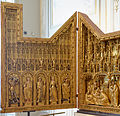
An altarpiece is an work of art in painting, sculpture or relief representing a religious subject made for placing at the back of or behind the altar of a Christian church. Though most commonly used for a single work of art such as a painting or sculpture, or a set of them, the word can also be used of the whole ensemble behind an altar, otherwise known as a reredos, including what is often an elaborate frame for the central image or images. Altarpieces were one of the most important products of Christian art especially from the late Middle Ages to the era of Baroque painting.

International Gothic is a period of Gothic art which began in Burgundy, France, and northern Italy in the late 14th and early 15th century. It then spread very widely across Western Europe, hence the name for the period, which was introduced by the French art historian Louis Courajod at the end of the 19th century.

Robert Campin, now usually identified with the Master of Flémalle, was a master painter who, along with Jan van Eyck, initiated the development of Early Netherlandish painting, a key development in the early Northern Renaissance.

Early Netherlandish painting is the body of work by artists active in the Burgundian and Habsburg Netherlands during the 15th- and 16th-century Northern Renaissance period, once known as the Flemish Primitives. It flourished especially in the cities of Bruges, Ghent, Mechelen, Leuven, Tournai and Brussels, all in present-day Belgium. The period begins approximately with Robert Campin and Jan van Eyck in the 1420s and lasts at least until the death of Gerard David in 1523, although many scholars extend it to the start of the Dutch Revolt in 1566 or 1568–Max J. Friedländer's acclaimed surveys run through Pieter Bruegel the Elder. Early Netherlandish painting coincides with the Early and High Italian Renaissance, but the early period is seen as an independent artistic evolution, separate from the Renaissance humanism that characterised developments in Italy. Beginning in the 1490s, as increasing numbers of Netherlandish and other Northern painters traveled to Italy, Renaissance ideals and painting styles were incorporated into northern painting. As a result, Early Netherlandish painters are often categorised as belonging to both the Northern Renaissance and the Late or International Gothic.
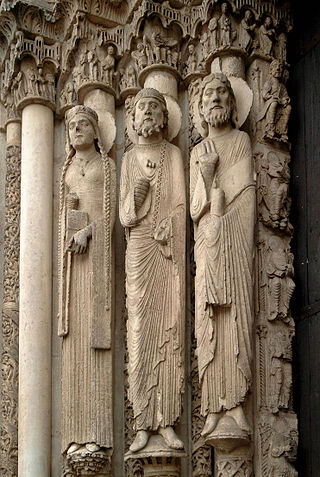
Gothic art was a style of medieval art that developed in Northern France out of Romanesque art in the 12th century AD, led by the concurrent development of Gothic architecture. It spread to all of Western Europe, and much of Northern, Southern and Central Europe, never quite effacing more classical styles in Italy. In the late 14th century, the sophisticated court style of International Gothic developed, which continued to evolve until the late 15th century. In many areas, especially Germany, Late Gothic art continued well into the 16th century, before being subsumed into Renaissance art. Primary media in the Gothic period included sculpture, panel painting, stained glass, fresco and illuminated manuscripts. The easily recognizable shifts in architecture from Romanesque to Gothic, and Gothic to Renaissance styles, are typically used to define the periods in art in all media, although in many ways figurative art developed at a different pace.

Stefan Lochner was a German painter working in the late International Gothic period. His paintings combine that era's tendency toward long flowing lines and brilliant colours with the realism, virtuoso surface textures and innovative iconography of the early Northern Renaissance. Based in Cologne, a commercial and artistic hub of northern Europe, Lochner was one of the most important German painters before Albrecht Dürer. Extant works include single-panel oil paintings, devotional polyptychs and illuminated manuscripts, which often feature fanciful and blue-winged angels. Today some thirty-seven individual panels are attributed to him with confidence.
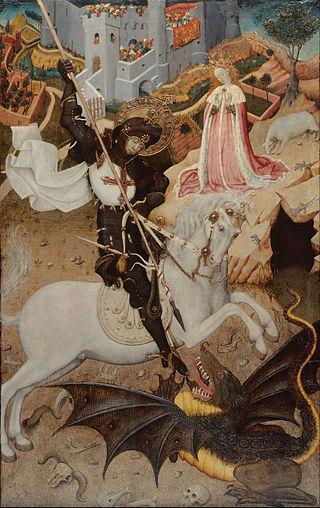
Bernat Martorell was the leading painter of Barcelona, in modern-day Spain. He is considered to be the most important artist of the International Gothic style in Catalonia. Martorell painted retable panels and manuscript illuminations, and carved sculptures and also provided designs for embroideries.

Henri Bellechose was a painter from the South Netherlands. He was one of the most significant artists at the beginning of panel painting in Northern Europe, and among the earliest artists of Early Netherlandish painting.
The Annunciation is an oil painting by the Early Netherlandish master Jan van Eyck, from around 1434–1436. The panel is housed in the National Gallery of Art in Washington, D.C. It was originally on panel but has been transferred to canvas. It is thought that it was the left (inner) wing of a triptych; there has been no sighting of the other wings since before 1817. The Annunciation is a highly complex work whose iconography is still debated by art historians. It was bought by the Tsar of Russia for the Hermitage Museum, but was sold by Stalin's government in 1930.

Melchior Broederlam was one of the earliest Early Netherlandish painters to whom surviving works can be confidently attributed. He worked mostly for Philip the Bold, Duke of Burgundy, and is documented from 1381 to 1409. Although only a single large pair of panel paintings can confidently be attributed to him, no history of Western painting can neglect his contribution.
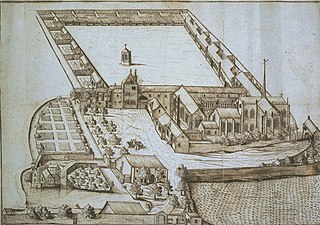
The Chartreuse de Champmol, formally the Chartreuse de la Sainte-Trinité de Champmol, was a Carthusian monastery on the outskirts of Dijon, which is now in France, but in the 15th century was the capital of the Duchy of Burgundy. The monastery was founded in 1383 by Duke Philip the Bold to provide a dynastic burial place for the Valois Dukes of Burgundy, and operated until it was dissolved in 1791, during the French Revolution.

Jean Malouel, or Jan Maelwael in his native Dutch, was a Dutch artist who was the court painter of Philip the Bold, Duke of Burgundy and his successor John the Fearless, working in the International Gothic style.

Crucifixion Diptych — also known as Philadelphia Diptych, Calvary Diptych, Christ on the Cross with the Virgin and St. John, or The Crucifixion with the Virgin and Saint John the Evangelist Mourning — is a diptych by the Early Netherlandish artist Rogier van der Weyden, completed c. 1460, today in the Philadelphia Museum of Art. The panels are noted for their technical skill, visceral impact and for possessing a physicality and directness unusual for Netherlandish art of the time. The Philadelphia Museum of Art describes this work as the "greatest Old Master painting in the Museum."

The Saint Augustine Altarpiece is a Catalan Gothic painting in egg tempera by Jaume Huguet and Pau Vergós made between 1462 and 1475. The long duration of the work was caused by financial reasons, and it is assumed that work was begun by Huguet and finished by other members of his workshop, in particular Pau Vergós. The altarpiece was commissioned by the guild of tanners to be placed on the altar of the Augustinian friary of Sant Agustí Vell in Barcelona, Spain. The panel measures 250 × 193 × 9.5 cm and has been in the Museu Nacional d'Art de Catalunya (MNAC) in Barcelona since 1927.
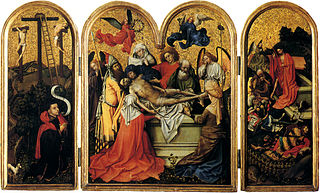
The Seilern Triptych, variously dated c. 1410-15 or c. 1420–25, is a large oil and gold leaf on panel, fixed winged triptych altarpiece generally attributed to the Early Netherlandish painter Robert Campin. It is the earliest of two known triptychs attributed to him, although the outer wing panels paintings are lost. The work details the events of Christ's passion; with iconography associated with the liturgy of Holy Week. The panels, which should be read from left to right, detail three stations of the cycle of the Passion of Jesus; the crucifixion, the burial and the resurrection.

Miniature Altarpiece with the Crucifixion is a very small and complex early 16th century Netherlandish microcarved miniature sculpture in boxwood, now in The Cloisters, New York. The central carvings of the upper triptych show the Crucifixion and Resurrection of Jesus, each outer wing contains two scenes from the biblical Old Testament. The complex base contains a round carving which opens like a boxwood prayer nut.

The Orsini Altarpiece, Orsini Polyptych or Passion Polyptych is a painting produced at an unknown location by Simone Martini for private devotion by a cardinal of the Orsini family. Its precise date is still under discussion. It was taken to France very early in its lifespan and formed a major influence on late medieval French artists. It is now split between the Louvre, the Royal Museum of Fine Arts, Antwerp and the Gemäldegalerie.

Adriaen van Overbeke, Adrian van Overbeck and Adriaen van Overbeke was a Flemish Renaissance painter in the style of Antwerp Mannerism. He operated a large workshop with an important output of altarpieces, which were mainly exported to Northern France, the Rhineland and Westphalia. His known works were predominantly polychromed wooden altarpieces with painted shutters, which were created through a collaboration between painters and sculptors.
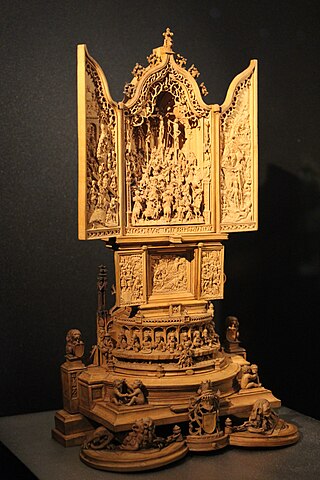
The miniature altarpiece in the British Museum, London, is a very small portable Gothic boxwood miniature sculpture completed in 1511 by the Northern Netherlands master sometimes identified as Adam Dircksz, and members of his workshop. At 25.1 cm (9.9 in) high, it is built from a series of architectural layers or registers, which culminate at an upper triptych, whose centre panel contains a minutely detailed and intricate Crucifixion scene filled with multitudes of figures in relief. Its outer wings show Christ Carrying the Cross on the left, and the Resurrection on the right.


